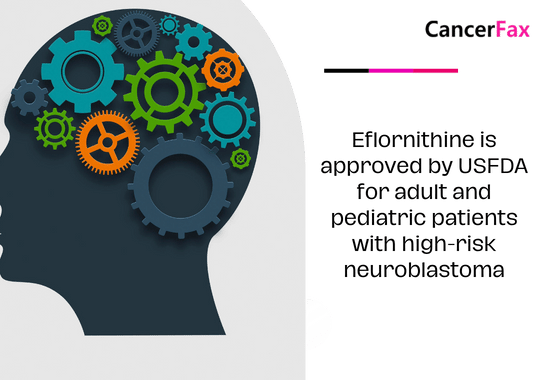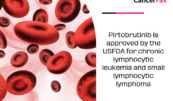Eflornithine is approved by USFDA for adult and pediatric patients with high-risk neuroblastoma
The FDA approved eflornithine (IWILFIN, USWM, LLC) on December 13, 2023, to lower the risk of relapse in adults and children with high-risk neuroblastoma (HRNB) who had a partial response to previous multiagent, multimodality therapy, such as anti-GD2 immunotherapy.
This marks the initial FDA approval of a treatment designed to lower the likelihood of relapse in juvenile patients with HRNB.
The effectiveness was assessed in a trial that compared results from Study 3b (the experimental group) with Study ANBL0032 (the external control group generated from a clinical trial). Study 3b (NCT02395666) was a multi-center trial that was open label and non-randomized, consisting of two cohorts. 105 eligible patients with high-risk neuroblastoma from one group (Stratum 1) were given eflornithine orally, twice daily at a dosage determined by body surface area (BSA) until disease progression, unacceptable toxicity, or for a maximum of 2 years. Study 3b was planned in advance to compare outcomes with the historical benchmark event free survival (EFS) rate from Study ANBL0032 as reported in published literature.
Study ANBL0032 was a multi-center, open-label, randomized trial that compared dinutuximab, granulocyte-macrophage colony-stimulating factor, interleukin-2, and cis-retinoic acid to cis-retinoic acid alone in pediatric patients with high-risk neuroblastoma. The external control arm was based on data from 1,241 patients in the experimental arm.
Patients who met the criteria for the comparison between Study 3b and ANBL0032 and had full data for certain clinical covariates were paired in a 3:1 ratio based on their propensity scores. The primary analysis included 90 patients treated with IWILFIN and 270 control patients from Study ANBL0032.
The primary efficacy measure was event-free survival (EFS), which encompassed disease progression, recurrence, secondary malignancy, or death from any cause. Another efficacy metric was overall survival (OS), which was defined as death from any cause. The EFS hazard ratio (HR) in the primary analysis was 0.48 with a 95% confidence interval (CI) of 0.27 to 0.85. The OS HR was 0.32 with a 95% CI of 0.15 to 0.70. Because of the uncertainty in estimating the treatment effect that comes with an externally controlled research design, extra analyses were done on subpopulations or using different statistical methods. The EFS HR varied between 0.43 (95% CI: 0.23, 0.79) and 0.59 (95% CI: 0.28, 1.27), while the OS HR ranged from 0.29 (95% CI: 0.11, 0.72) to 0.45 (95% CI: 0.21, 0.98).
In Study 3b, the most common side effects (≥5%), which also included lab abnormalities, were stuffy nose, diarrhea, cough, sinusitis, pneumonia, upper respiratory tract infection, conjunctivitis, vomiting, fever, allergic rhinitis, lower neutrophils, higher ALT and AST, hearing loss, skin infection, and urinary tract infection.
Susan Hau is a distinguished researcher in the field of cancer cell therapy, with a particular focus on T cell-based approaches and cancer vaccines. Her work spans several innovative treatment modalities, including CAR T-cell therapy, TIL (Tumor-Infiltrating Lymphocyte) therapy, and NK (Natural Killer) cell therapy.
Hau's expertise lies in cancer cell biology, where she has made significant contributions to understanding the complex interactions between immune cells and tumors.
Her research aims to enhance the efficacy of immunotherapies by manipulating the tumor microenvironment and exploring novel ways to activate and direct immune responses against cancer cells.
Throughout her career, Hau has collaborated with leading professors and researchers in the field of cancer treatment, both in the United States and China.
These international experiences have broadened her perspective and contributed to her innovative approach to cancer therapy development.
Hau's work is particularly focused on addressing the challenges of treating advanced and metastatic cancers. She has been involved in clinical trials evaluating the safety and efficacy of various immunotherapy approaches, including the promising Gamma Delta T cell therapy.
- Comments Closed
- March 5th, 2024






Eflornithine approval, FDA-approved neuroblastoma drugs 2023, High-risk neuroblastoma treatment, Iwilfin for neuroblastoma, Maintenance therapy for NB, ODC inhibitor therapy, Pediatric cancer breakthrough, Survival improvement in pediatric oncology
CancerFax is the most trusted online platform dedicated to connecting individuals facing advanced-stage cancer with groundbreaking cell therapies.
Send your medical reports and get a free analysis.
🌟 Join us in the fight against cancer! 🌟
Привет,
CancerFax — это самая надежная онлайн-платформа, призванная предоставить людям, столкнувшимся с раком на поздних стадиях, доступ к революционным клеточным методам лечения.
Отправьте свои медицинские заключения и получите бесплатный анализ.
🌟 Присоединяйтесь к нам в борьбе с раком! 🌟